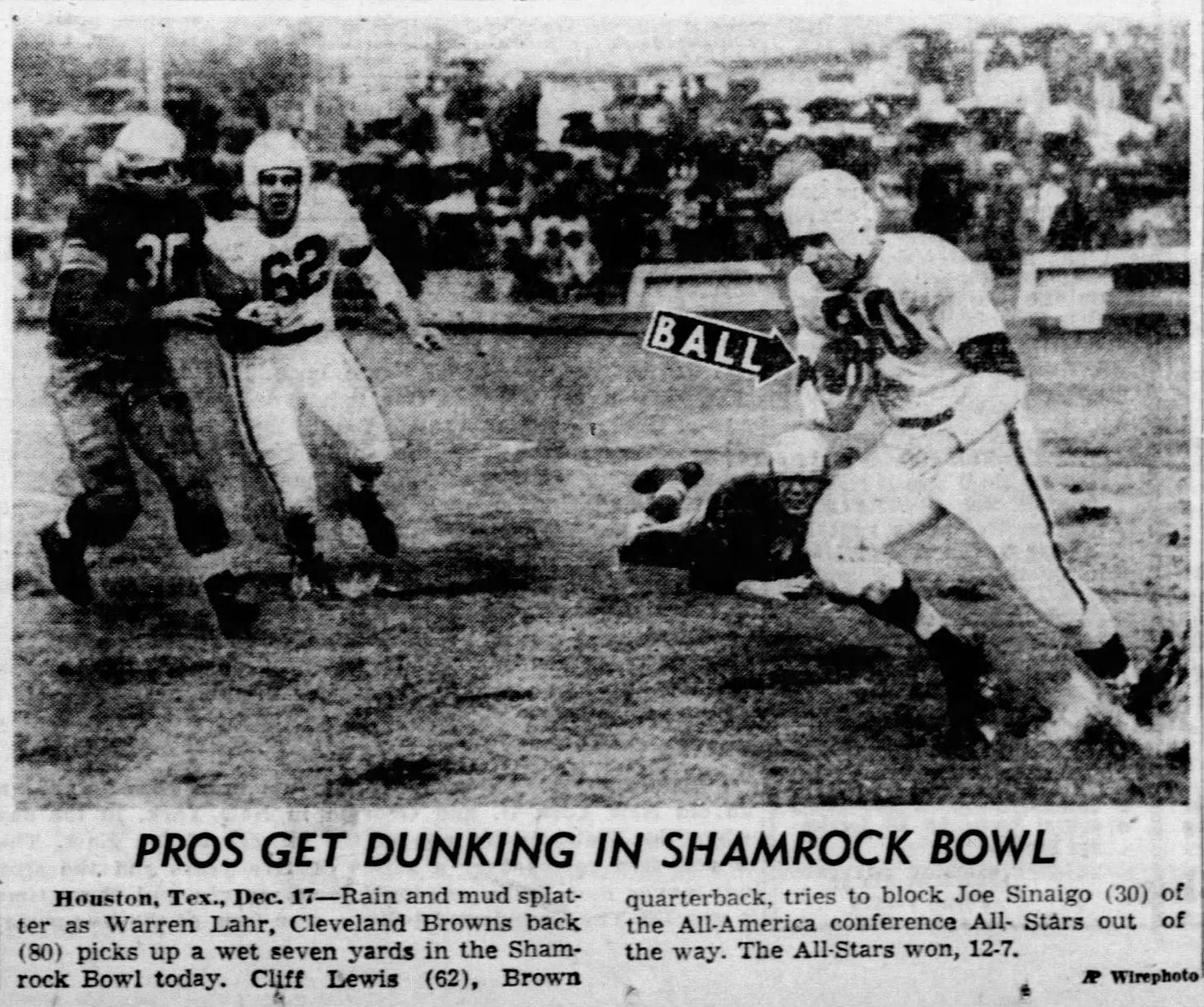Today's Tidbit... Glenn McCarthy And Houston's Giant Stadium
In the late 1940s, the NFL and AAFC competed for football talent and the nation's attention, with entrepreneurs in Buffalo and Houston seeking to attract a franchise from whichever league gave them the first opportunity. A barrier to Houston gaining a franchise was the lack of a football stadium large enough for the pros, though Rice and the University of Houston were considering expanding or replacing their stadiums. Into the breach stepped Glenn H. McCarthy, who had earned several fortunes as an oil wildcatter and was the basis of Edna Ferber's novel Giant and the character played by James Dean in the movie of the same name. McCarthy proposed a 100,000-seat stadium with a retractable aluminum roof, with space to add 20,000 to 30,000 more temporary seats for significant events. McCarthy's Houston Stadium never came to pass, though it may have inspired the Astrodome that arrived in 1964.
McCarthy personified the rags-to-riches-to-rags-to-riches story, and like others who fit that description, elements of his background story get inflated and conflated over time, so it becomes difficult to separate fact from fiction. Although profiles suggest he played at Tulane, Texas A&M, and Rice, I could verify only portions of that story.
The son of an itinerant oilfield worker, the McCarthy family settled in Houston in the mid-1920s, allowing McCarthy to attend San Jacinto High, where he starred as a lineman. He impressed Paul Tyson, Waco High's famous coach, in a losing playoff effort in 1926, and his efforts earned him at least one all-state mention.
The legend says McCarthy earned a football scholarship to Tulane. However, his lack of scholarship in the classroom led to his spending the 1927 season at Warren Easton High in New Orleans, where he led the team to the state playoffs. News accounts of the era indicate that Warren Easton was booted from the playoffs partway through when the authorities found McCarthy ineligible due to not earning any academic credits the previous school year.
McCarthy returned to Texas and appears to have enrolled at Texas A&M, perhaps participating in spring football. In September 1929, McCarthy was one of six “upperclassmen” suspended for hazing incoming freshmen. He then spent the 1928 season at Allen Academy, near Texas A&M, where he lettered and was one of the team's stars.
McCarthy's profile also suggests he moved on to Rice and was a member of the 1932 Southwest Conference championship team. However, the only traces found of him at Rice include his winning numerals as a member of the 1930 freshman team and being listed as a prospect for the 1930 football team. He does not appear in news accounts or Rice's all-time lettermen list.
By 1934 or earlier, McCarthy was a wildcatter. He struck it rich by outworking, outgambling, and outpromoting others, finding oil by drilling deeper or in locations others had not drilled. Like the Jett Rink in Giant, oil was not the only liquid McCarthy enjoyed. By all accounts, he was a boisterous promoter who regularly gave back to his community, sponsoring a range of efforts targeted toward youth.
His desire to promote himself and Houston in the post-WWII era led to his building the Shamrock Hotel. A lavish 14-story hotel located too far from the business district to make sense financially, but its grand opening included stars brought by plane and train from Hollywood and a $1 million promotional bill.

While the Shamrock was under construction, McCarthy tried to acquire an NFL or AAFC franchise and offered to donate the $3 million toward the $6.5 million cost of building the roofed stadium. However, those plans did not materialize. He also proposed a 1949 version of the Super Bowl, a World Series game between the NFL and AAFC champs.
McCarthy succeeded in hosting the Shamrock Bowl in December 1949. The game featured the 1949 AAFC champion Cleveland Browns against the all-stars of the rest of the AAFC. Played on a rainy day at Rice Stadium, the Shamrock Bowl attracted only 10,000 fans. The 12-7 All-Star win was the final AAFC game.
With the AAFC's demise, McCarthy worked to obtain an NFL expansion team for the 1950 season, proposing once again to build the 100,000-seat stadium. However, the league held off on expansion other than to accept three AAFC teams for the 1950 season. McCarthy pursued the NFL for a few more seasons, but nothing came of it, and by the time the AFL arrived in 1960, another oilman, Bud Adams, obtained the franchise.

Football Archaeology is reader-supported. Click here to buy one of my books or otherwise support the site.





Given McCarthy's well-earned and well-known sobriquet as "King of the Wildcatters", it seems almost certain that if the NFL owners had voted in 1950 to award him a franchise, it wouldve been called the Houston Wildcatters.
An early proposal for Yale Bowl (1914) had it also seating 100,000, which was backed down to around 72,000. It was just as well; the architect left out the restrooms, which weren't added until 1929 ..